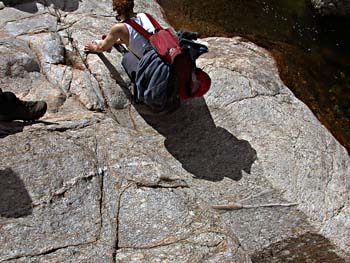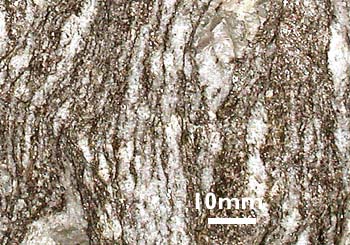|
|
|
Augen within the solid rocks
At location 4 the augen gneiss (or
orthogneiss) forms the solid rock. Although the rock appears to
be a cold light grey, close up we can seen that it's a stripy light
and darker grey with narrow bands of small black flecks.
|
| |
 |
| Large rock surfaces with augen
smoothed by the grinding action of sediment in the river |
| |
| This rock is a medium to coarse
grained, banded rock. There are many large white-light grey inclusions
surrounded by areas where the stripes are deformed in the shape of
eyes (hence "augen" the German for eyes). |
| |
The rock composition
This rock has roughly the same minerals as that of granite, with quartz
dominant (50%) (translucent crystals) and lower amounts of feldspar
(35%) (whitish and less obviously crystalline) and lower still amounts
of mica in the form of biotite (black-brown-metallic platy crystals)
and muscovite (clear and lustrous often paper thin crystals) (10-20%)
. It's this mix of minerals which creates its fairly neutral (if stripy)
colour. |
| |
The metamorphism
However, like the rock at location 1,
the rocks here have been metamorphosed. As we have moved further into
the Gorge we can see the ravine sides towering above us and we realise
that the gorge has cut down into rock by about 500m. These rocks are
today at some distance below the "Real ground level" and
at the time of metamorphic change some 280-300 million years ago were
even more deeply buried. |
| |
Metamorphic grade
As the rocks at this location were buried
deeper, they were subjected to greater pressure and, probably even
more, to a higher temperature. This results in changes to the texture
of the rock, and in the balance of minerals. These are progressive,
and result in a series of "grades" of metamorphism.
|
| |
 |
| The stripy banding is typical
of medium to high grade metamorphism |
| |
Stripy Structures
The stripes in higher grade metamorphic
rocks are an example of so called "compositional segregation"
(see the close up photo above). Under the influence of the pressure
and temperature of deep burial (several km underground), recrystallization
occurred slowly with a realigning of the platy mica crystals in a
direction at right angles to the direction of the pressure. The quartz
(light in colour) and biotite (the black form of mica) separate out
in bands of around 2-3 mm and 1-3 cm also at right angles to the line
of pressure. |
| |
For more inf. on the
origin of the augen and the rock texture,
go to augen.
|
| |
|
| |
|
|
